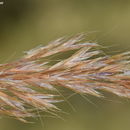Associations
provided by BioImages, the virtual fieldguide, UK
Foodplant / miner
larva of Agromyza nigrella mines leaf of Trisetum flavescens
In Great Britain and/or Ireland:
Foodplant / parasite
Blumeria graminis parasitises live Trisetum flavescens
Foodplant / pathogen
pycnidium of Dilophospora coelomycetous anamorph of Lidophia graminis infects and damages live inflorescence of Trisetum flavescens
Remarks: season: 5-10, esp. 7
Foodplant / parasite
uredium of Puccinia graminis f.sp. avenae parasitises live stem of Trisetum flavescens
Foodplant / parasite
amphigenous telium of Puccinia hordei parasitises live leaf of Trisetum flavescens
Foodplant / spot causer
long, linear, erumpent sorus of Ustilago hypodytes causes spots on live, blistered leaf of Trisetum flavescens
Comprehensive Description
provided by North American Flora
Trisetum flavescens (L.) Beauv. Agrost. 88, 153, 180. 1812
Aiena flavescens L. Sp. PI. 80. 1753.
Trisetum pratense Pers. Syn. PI. 1: 97. 1805. (Type from Europe.)
Trisetaria flavescens Baumg. Enum. Stirp. Transsilv. 3: 263. 1816. (Based on Avena flavescens "Schreb.")
Perennial; culms solitary or few in a tuft, erect or decumbent at base, glabrous, sometimes pilose at or below the nodes, 30-60 cm. tall; sheaths glabrous or sometimes with a few weak hairs; ligule truncate, erose-dentate, 1-2 mm. long; blades flat, scabrous beneath, more or less pilose on the upper surface, scabrous on the margin, 3-7 mm. wide; panicle narrow, rather loose, many-flowered, yellowish, 10-20 cm. long, the axis smooth or somewhat scabrous above, the branches verticillate, scabrous, rather distant but overlapping, flexuous; spikelets mostly 3-4-flowered, 6-8 mm. long, usually golden-yellow, the rachilla villous; glumes glabrous except the keel, the first narrow, 1-nerved, 4 mm. long, the second broader, 3-nerved, about 6 mm. long; lemma glabrous or scaberulous, about 4 mm. long; awn attached above the middle of the lemma, geniculate-spreading, the lower part flexuous or twisted.
Typb locality: Europe.
Distribution: Introduced in a few places from Vermont to Missouri and California; native of Europe.
- bibliographic citation
- Albert Spear Hitchcock, Jason Richard Swallen, Agnes Chase. 1939. (POALES); POACEAE (pars). North American flora. vol 17(8). New York Botanical Garden, New York, NY
Physical Description
provided by USDA PLANTS text
Perennials, Terrestrial, not aquatic, Rhizomes present, Rhizome short and compact, stems close, Stems nodes swollen or brittle, Stems erect or ascending, Stems geniculate, decumbent, or lax, sometimes rooting at nodes, Stems caespitose, tufted, or clustered, Stems terete, round in cross section, or polygonal, Stem nodes bearded or hairy, Stem internodes hollow, Stems with inflorescence less than 1 m tall, Stems, culms, or scapes exceeding basal leaves, Leaves m ostly basal, below middle of stem, Leaves mostly cauline, Leaves conspicuously 2-ranked, distichous, Leaves sheathing at base, Leaf sheath mostly open, or loose, Leaf sheath smooth, glabrous, Leaf sheath hairy, hispid or prickly, Leaf sheath and blade differentiated, Leaf blades linear, Leaf blades 2-10 mm wide, Leaf blades mostly flat, Leaf blades mostly glabrous, Leaf blades more or less hairy, Ligule present, Ligule an unfringed eciliate membrane, Inflorescence terminal, Inflorescence an open panicle, openly paniculate, branches spreading, Inflorescence solitary, with 1 spike, fascicle, glomerule, head, or cluster per stem or culm, Inflorescence branches more than 10 to numerous, Flowers bisexual, Spikelets pedicellate, Spikelets laterally compressed, Spikelet less than 3 mm wide, Spikelets with 2 florets, Spikelets with 3-7 florets, Spikelets solitary at rachis nodes, Spikelets all alike and fertille, Spikelets bisexual, Spikelets disarticulating above the glumes, glume s persistent, Spikelets disarticulating beneath or between the florets, Rachilla or pedicel hairy, Glumes present, empty bracts, Glumes 2 clearly present, Glumes distinctly unequal, Glumes equal to or longer than adjacent lemma, Glumes keeled or winged, Glumes 1 nerved, Glumes 3 nerved, Lemma similar in texture to glumes, Lemma 5-7 nerved, Lemma glabrous, Lemma apex dentate, 2-fid, Lemma distinctly awned, more than 2-3 mm, Lemma with 1 awn, Lemma awn less than 1 cm long, Lemma awn subapical or dorsal, Lemma awns straight or curved to base, Lemma awn once geniculate, bent once, Lemma margins thin, lying flat, Lemma straight, Callus or base of lemma evidently hairy, Callus hairs shorter than lemma, Palea present, well developed, Palea membranous, hyaline, Palea longer than lemma, Palea 2 nerved or 2 keeled, Stamens 3, Styles 2-fid, deeply 2-branched, Stigmas 2, Fruit - caryopsis.
Trisetum flavescens: Brief Summary
provided by wikipedia EN
Trisetum flavescens, the yellow oatgrass or golden oat grass, is a species of grass in the family Poaceae. It is native to Europe, Asia, and North Africa.
It can be found elsewhere, such as sections of North America, where it was introduced as a rangeland grass for grazing. It now exists in the wild as a common weed.
- license
- cc-by-sa-3.0
- copyright
- Wikipedia authors and editors

